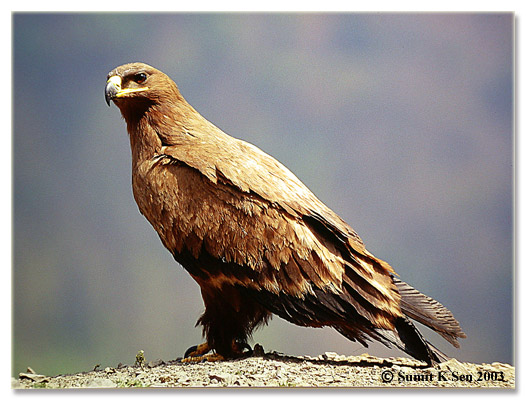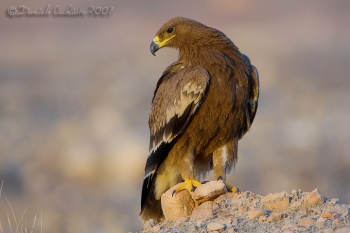(add photo) |
(id, ref) |
||
| Line 3: | Line 3: | ||
==Identification== | ==Identification== | ||
62-74 cm<br /> | 62-74 cm<br /> | ||
| − | Brown upperparts and blackish flight feathers and tail, pale throat. | + | Brown upperparts and blackish flight feathers and tail, pale throat.<br /> |
| + | Gape line goes back behind the mid of the eye, often to the rear edge but not always. | ||
| + | ====Similar species==== | ||
| + | In Europe look at [[Greater Spotted Eagle]] and [[Lesser Spotted Eagle]]; in Africa also [[Tawny Eagle]] and [[Wahlberg's Eagle]] | ||
==Distribution== | ==Distribution== | ||
[[Image:4578IMG 9871.jpg|thumb|350px|right|Probably second year bird. <br />Photo by {{user|rony_roshtov|rony_roshtov}}<br />Eylat, [[Israel]], April 2006]] | [[Image:4578IMG 9871.jpg|thumb|350px|right|Probably second year bird. <br />Photo by {{user|rony_roshtov|rony_roshtov}}<br />Eylat, [[Israel]], April 2006]] | ||
| Line 29: | Line 32: | ||
The diet includes fresh carrion of all kinds, also rodents and other small mammals up to the size of a rabbit, and birds up to the size of partridges. It will also snatch food from other raptors. | The diet includes fresh carrion of all kinds, also rodents and other small mammals up to the size of a rabbit, and birds up to the size of partridges. It will also snatch food from other raptors. | ||
==References== | ==References== | ||
| − | #{{Ref-Clements6thDec08}} | + | #{{Ref-Clements6thDec08}}# Sinclair et al. 2002. Birds of Southern Africa. Princeton Field Guides, Princeton, New Jersey, USA. ISBN 0-691-09682-1 |
{{ref}} | {{ref}} | ||
==External Links== | ==External Links== | ||
Revision as of 19:04, 21 May 2011
- Aquila nipalensis
Identification
62-74 cm
Brown upperparts and blackish flight feathers and tail, pale throat.
Gape line goes back behind the mid of the eye, often to the rear edge but not always.
Similar species
In Europe look at Greater Spotted Eagle and Lesser Spotted Eagle; in Africa also Tawny Eagle and Wahlberg's Eagle
Distribution
Breeds from the northern slopes of the Caucasus to the north of the Caspian Sea in southern Russia and Kazakhstan and east into Central Asia as far as north-west China and Tibet. Probably now extinct in the Ukraine and a former breeder in Moldova, Romania and Turkey. Further south breeds in Pakistan, India and Burma.
In the northern winter found mainly in Eastern and Southern Africa, small numbers in Iraq and Israel, occasionally Greece and Turkey. On passage occurs in Turkey and the Middle East, Sinai and Egypt but generally rather scarce. Eastern birds winter south to Pakistan, India and southern China.
Annual or almost so in Sweden and Finland, vagrants also recorded west to the Netherlands and France, various European countries and south to Sardinia, Tunisia and Chad.
Taxonomy
Considered conspecific with Tawny Eagle Aquila rapax by some authors. The subspecies vindhiana of the latter is sometimes included in this species.
Subspecies[1]
Subspecies:
- A. n. orientalis:
- Central Eurasia; winters to Middle East, Arabia and southern Africa
- A. n. nipalensis:
Habitat
Lowland steppe, semi-desert and foothills
Behaviour
Diet
The diet consists mostly of carrior, but will kill rodents, small mammals and birds. The diet includes fresh carrion of all kinds, also rodents and other small mammals up to the size of a rabbit, and birds up to the size of partridges. It will also snatch food from other raptors.
References
- Clements, JF. 2008. The Clements Checklist of Birds of the World. 6th ed., with updates to December 2008. Ithaca: Cornell Univ. Press. ISBN 978-0801445019.
- Sinclair et al. 2002. Birds of Southern Africa. Princeton Field Guides, Princeton, New Jersey, USA. ISBN 0-691-09682-1
Recommended Citation
- BirdForum Opus contributors. (2024) Steppe Eagle. In: BirdForum, the forum for wild birds and birding. Retrieved 25 April 2024 from https://www.birdforum.net/opus/Steppe_Eagle






